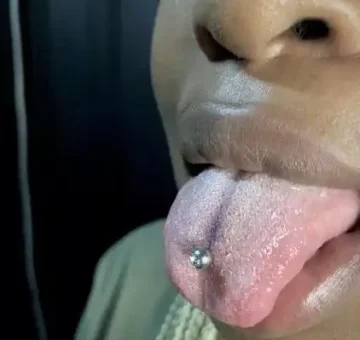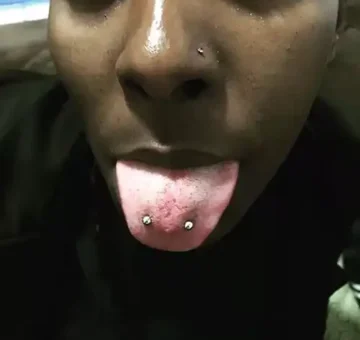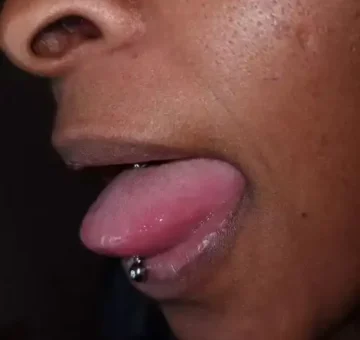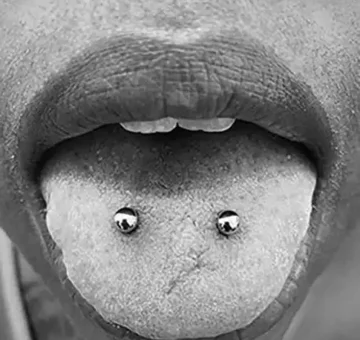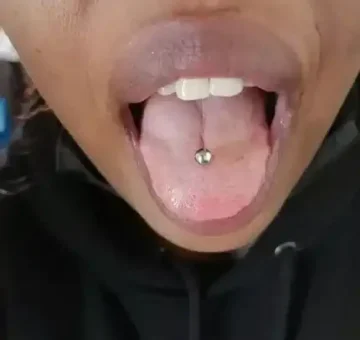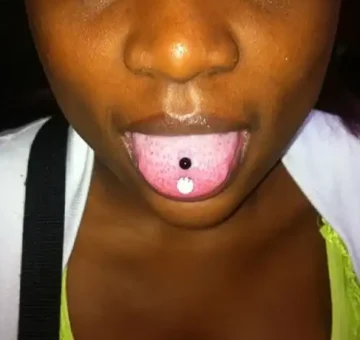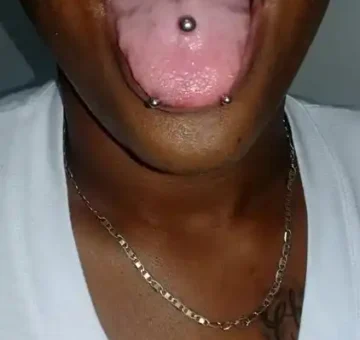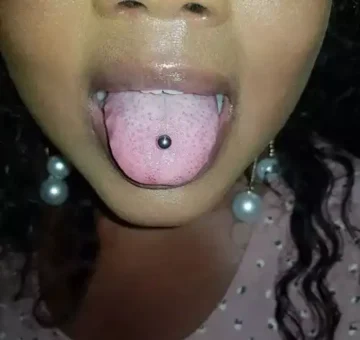Tongue Piercings
Key Points About Tongue Piercing
- Location: The piercing is usually placed in the center of the tongue, but alternative placements like side or tip piercings are also possible.
- Jewelry: The most common type of jewelry used is a straight barbell, available in various materials like surgical steel, titanium, or biocompatible plastics.
- Purpose: Tongue piercings are done for self-expression, aesthetic enhancement, or as a cultural or personal statement.
- Popularity: It’s a bold and edgy choice, often considered unique compared to more traditional piercings.
Tongue Piercing Variations
Tongue piercings have evolved to include various styles and placements, offering unique ways to express individuality. Here are some popular tongue piercing variations:
- Midline Tongue Piercing (Standard Tongue Piercing)
– Placement: Center of the tongue along the midline.
– Jewelry: Typically a straight barbell.
– Popularity: The most common and versatile option. - Side Tongue Piercing
– Placement: Off-center on either side of the tongue.
– Jewelry: Straight or curved barbells.
– Ideal For: Those looking for an asymmetrical or edgy look. - Snake Eyes Piercing
– Placement: Horizontal piercing at the tip of the tongue, creating a “double-eyed” appearance.
– Jewelry: Curved barbell or specialty jewelry.
– Note: Higher risk of damage to teeth and gums. - Horizontal Tongue Piercing
– Placement: Horizontally across the tongue, rather than top-to-bottom.
– Jewelry: Straight or curved barbells.
– Complexity: Requires careful aftercare due to placement. - Venom Piercings
– Placement: Two piercings placed symmetrically on either side of the tongue.
– Jewelry: Straight barbells.
– Effect: Creates a bold and striking look. - Surface Tongue Piercing
– Placement: On the surface of the tongue, running parallel to the tongue’s length.
– Jewelry: Surface barbells.
– Risk: High rejection rate due to its superficial nature. - Web (Frenulum) Piercing
– Placement: Underneath the tongue, through the frenulum (the web-like skin connecting the tongue to the mouth).
– Jewelry: Curved or circular barbells.
– Subtlety: A discreet option often hidden from view. - Double Tongue Piercing
– Placement: Two midline piercings placed either vertically or horizontally.
– Jewelry: Straight barbells.
– Uniqueness: Provides a dramatic and eye-catching effect. - Tongue Tip Piercing
– Placement: At the very tip of the tongue.
– Jewelry: Small barbells or studs.
– Popularity: Great for a subtle yet noticeable look.
Things to Consider
- Healing Time: Tongue piercings typically heal in 4-6 weeks but vary based on placement.
- Professional Piercing: Ensure all procedures are done by experienced piercers to minimize risks.
- Aftercare: Follow strict oral hygiene practices to avoid complications.
Tongue Piercing Procedure
A tongue piercing involves creating a hole in the tongue to insert jewelry, such as a barbell. Here’s a step-by-step guide to the procedure:
Preparation
- Consultation:
– Discuss placement, jewelry options, and any concerns with the piercer.
– Inform the piercer about allergies, medical conditions, or medications. - Sterilization:
– Our piercer sanitizes all tools and jewelry.
– Disposable gloves and a sterile needle are used to prevent infection. - Marking:
– Our piercer marks the exact spot on your tongue where the piercing will go.
– You will be asked to check and approve the placement. - Mouth Rinse: An antibacterial, alcohol-free mouthwash is used to disinfect the oral area.
Piercing Process
- Tongue Stabilization: A clamp may be used to hold the tongue steady and minimize movement.
- Piercing:
– A hollow needle is used to puncture the tongue at the marked spot.
– This process is quick and usually takes a few seconds. - Jewelry Insertion: The barbell is immediately inserted into the new piercing to keep the hole open.
Post-Piercing Steps
- Rinse: You may be asked to rinse your mouth again to clean the area.
- Instructions: The piercer will provide detailed aftercare instructions, including how to clean the piercing and manage swelling.
What to Expect
- Pain: The procedure is generally quick and relatively painless, though some discomfort is normal.
- Swelling: Swelling is common for a few days but should subside with proper care.
Considerations Before Getting a Tongue Piercing
A tongue piercing is a stylish and bold choice, but it requires thoughtful preparation to ensure safety and satisfaction. Here are the key factors to consider before committing to the procedure:
- Health and Medical Concerns
– Overall Health: Ensure you are in good health before getting pierced, as illnesses can delay healing or increase risks.
– Medical Conditions: Avoid tongue piercings if you have conditions such as diabetes, blood clotting disorders, or a compromised immune system. Consult your doctor if you’re unsure.
– Oral Health: Address issues like gum disease, cavities, or other dental problems before the procedure. - Professional Piercer and Studio Selection
– Certified Piercer: Choose an experienced, professional piercer with a good reputation.
– Hygiene Standards: Ensure the studio uses sterilized equipment, disposable needles, and follows strict hygiene protocols. - Risks and Complications
– Swelling: Tongue swelling is normal after the piercing and can temporarily affect speech and eating.
– Infection: The mouth harbors bacteria, making proper aftercare crucial to prevent infection.
– Tooth and Gum Damage: Jewelry can chip teeth or irritate gums if you accidentally bite it or if it is too long.
– Nerve Damage: Rare but possible if the piercing is done incorrectly.
– Allergic Reactions: Use jewelry made from hypoallergenic materials like titanium or surgical steel to avoid reactions. - Lifestyle Adjustments
– Speech and Eating: Temporary difficulty speaking and eating is common during the healing process.
– Diet Restrictions: Avoid spicy, acidic, or hard foods during healing. Stick to soft foods initially.
– Workplace Policies: Some workplaces have restrictions on visible piercings—check if this applies to you. - Healing and Aftercare Commitment
– Healing Time: Initial healing takes 4-6 weeks, but complete healing may take up to 3 months.
– Aftercare Requirements:
→ Rinse your mouth with a non-alcoholic, antibacterial mouthwash after meals and drinks.
→ Avoid smoking, alcohol, and playing with the jewelry during healing. - Jewelry Choices
– Material: Opt for high-quality materials like titanium or surgical steel for the initial piercing.
– Size: Start with a slightly longer barbell to accommodate swelling, and switch to a shorter one once healing is complete. - Cost and Maintenance
– Cost of Piercing: Factor in the cost of the procedure and high-quality jewelry.
– Long-Term Care: Regularly clean the jewelry and monitor for signs of irritation or buildup. - Emotional and Physical Readiness
– Pain Tolerance: Be prepared for some discomfort during and after the procedure.
– Commitment: Ensure you are ready to follow the strict aftercare routine for optimal healing.
Tongue Piercings FAQ’s
Pain and Healing of Tongue Piercing
Tongue piercings are known for their unique style, but they also involve specific levels of discomfort and a healing process that requires commitment. Here’s what to expect:
Pain Level
- During the Procedure:
– Pain is generally mild to moderate.
– The piercing process is quick, lasting only a few seconds.
– Most people describe it as a sharp pinch followed by slight pressure. - After the Procedure:
– Some soreness and swelling are normal for the first few days.
– Pain typically subsides within a week.
Factors Influencing Pain:
- Individual pain tolerance.
- The skill of the piercer.
- Proper placement of the piercing.
Healing Process
Initial Healing Phase (First 4-7 Days)
- Swelling:
– Tongue swelling is common and can make talking and eating challenging.
– Ice chips and cold drinks can help reduce swelling. - Pain:
– Mild to moderate discomfort is normal.
– Over-the-counter pain relievers (non-aspirin) can help.
Intermediate Phase (4-6 Weeks)
- Tissue Recovery:
– The tongue starts to adapt, and pain or sensitivity diminishes significantly.
– Swelling should completely subside. - Jewelry Adjustment: The initial long barbell can be replaced with a shorter one once the swelling is gone.
Complete Healing (Up to 3 Months)
- The piercing fully heals, and the tissue around the jewelry stabilizes.
- Regular cleaning becomes routine maintenance rather than intensive care.
Signs of Normal Healing vs. Complications
- Normal Healing:
– Swelling and minor soreness.
– A clear or whitish discharge (not pus). - Signs of Infection or Issues:
– Persistent redness, severe swelling, or pain.
– Yellow or green discharge with a foul odor.
– Difficulty breathing or extreme swelling (seek medical help immediately).
Tongue Piercing Aftercare Guide
Proper aftercare is essential for the healing process and to prevent complications like infections or irritation. Follow these guidelines for effective tongue piercing aftercare:
- Immediate Aftercare
– Rinse Your Mouth:
→ Use a non-alcoholic, antibacterial mouthwash after eating, drinking, or smoking.
→ Avoid alcohol-based rinses as they can irritate the piercing.
– Ice to Reduce Swelling: Suck on ice chips or drink cold water to minimize swelling during the first few days. - Cleaning Routine
– Morning and Night Cleaning:
→ Gently rinse your mouth with saline solution or antibacterial mouthwash.
→ Brush your teeth and tongue gently to remove plaque and bacteria.
– Jewelry Cleaning: Ensure the jewelry stays clean by rinsing it during regular cleaning routines. - Diet Recommendations
– Eat Soft Foods:
→ Stick to soft and bland foods like yogurt, mashed potatoes, and soups.
→ Gradually reintroduce regular foods as the piercing heals.
– Avoid Irritants: Stay away from spicy, acidic, or hard foods that can irritate the piercing. - Lifestyle Adjustments
– Avoid Smoking and Alcohol: Smoking and alcohol can delay healing and increase the risk of infection.
– No Playing with Jewelry: Avoid touching or playing with the jewelry to prevent irritation or damage.
– Limit Oral Contact: Refrain from kissing or oral activities that can introduce bacteria until the piercing has healed. - Monitor for Complications
– Normal Signs: Minor swelling, soreness, and a clear or whitish discharge are normal during the healing process.
– Seek Help If You Notice:
→ Persistent redness, severe pain, extreme swelling, or yellow/green discharge (signs of infection).
→ Difficulty breathing or speaking due to excessive swelling (seek medical attention immediately). - Long-Term Care
– Replace Jewelry as Needed:
→ Switch to a shorter barbell after swelling subsides, typically within 2-4 weeks.
→ Always use high-quality, hypoallergenic materials like titanium or surgical steel.
– Maintain Oral Hygiene:
→ Brush and floss daily to keep your mouth clean.
→ Clean the piercing regularly to prevent buildup or irritation.
Healing Time
- Initial Healing: 4-6 weeks.
- Complete Healing: Up to 3 months.
Tongue Piercing Jewelry: Types, Materials, and Considerations
Choosing the right jewelry for a tongue piercing is crucial for comfort, healing, and style. Here’s a detailed guide on tongue piercing jewelry:
Common Types of Tongue Piercing Jewelry
- Straight Barbell
– Description: A straight rod with threaded balls on both ends.
– Use: The most popular and practical choice for tongue piercings.
– Advantages: Comfortable, versatile, and available in various lengths and styles. - Curved Barbell
– Description: Slightly curved jewelry with threaded balls on either end.
– Use: Often used for snake eyes or surface tongue piercings.
– Advantages: Reduces stress on tissue for certain placements. - Captive Bead Ring (CBR)
– Description: A circular ring with a single bead that locks the jewelry in place.
– Use: Rarely used for tongue piercings but an option for creative placements.
– Advantages: Unique aesthetic. - Custom or Decorative Jewelry
– Description: Includes barbells with gemstones, colored acrylics, or playful designs.
– Use: Popular after full healing to showcase personal style.
– Advantages: Variety of designs to suit individual preferences.
Best Materials for Tongue Jewelry
- Titanium
– Hypoallergenic and lightweight.
– Ideal for initial piercings to prevent allergic reactions. - Surgical Steel
– Affordable and widely available.
– Durable and safe for healed piercings. - Bioplast or PTFE (Flexible Plastic)
– Flexible and gentle on teeth and gums.
– Great for reducing irritation during healing. - Gold (14K or Higher)
– Luxurious and stylish.
– Ensure high purity to avoid allergic reactions. - Acrylic or Silicone
– Lightweight and available in vibrant colors.
– Best for short-term wear after healing.
Choosing the Right Jewelry Size
- Length
– Initial Jewelry: A longer barbell (16-22mm) is used to accommodate swelling.
– After Healing: A shorter barbell (10-16mm) can be fitted for comfort and aesthetics. - Gauge
– Standard Size: 14G (1.6mm) is the most common thickness for tongue piercings.
– Smaller or Larger Gauges: Available for custom looks or stretched piercings.
Considerations for Tongue Piercing Jewelry
- Comfort: Avoid jewelry with sharp edges or overly decorative ends during healing.
- Durability: Select materials that resist tarnishing and corrosion.
- Teeth and Gum Safety:
– Use rounded or smooth jewelry to prevent chipping or gum recession.
– Switch to flexible materials if irritation occurs.
Jewelry Care Tips
- Clean jewelry regularly with a saline solution or gentle soap and water.
- Check for loose balls or beads to avoid accidental swallowing.
- Replace damaged or worn-out jewelry promptly to maintain comfort and hygiene.
Cost of a Tongue Piercing in Nairobi, Kenya
The cost of a tongue piercing can vary depending on several factors, including the location, piercer’s expertise, and the type of jewelry chosen. Here’s a breakdown of what you might expect:
General Cost Range
- Typical Price: Ksh. 1,500 to Ksh. 2,500
- Variations:
– Lower-end: Basic piercings with standard jewelry at less renowned studios.
– Higher-end: Studios with experienced piercers, premium jewelry, or in major cities.
Factors Influencing Cost
- Location of the Studio: Urban or high-demand areas often charge more than rural or smaller towns. Rebel Inks Tattoos, Tattoo Removal, and Body Piercings Parlour is located in the heart of the Central Business Disrict (CBD) in Nairobi, Kenya, and is easily accessible to both locals and foreigners in the country.
- Experience of the Piercer: Highly skilled and reputable piercers tend to charge more for their services. At Rebel Inks Tattoos, Tattoo Removal, and Body Piercings Parlour we have experienced professionals who offer quality and premium services.
- Jewelry Type and Material
– Standard Jewelry: Surgical steel or titanium is usually included in the base price.
– Premium Jewelry: Gold, gemstones, or custom designs may add Ksh. 500 to Ksh. 1,000 or more. - Additional Costs
– Consultation Fee: Some studios may charge extra for consultations.
– Aftercare Products: Antibacterial mouthwash, saline solution, or cleaning kits can cost Ksh. 500 to Ksh. 2,000
– Jewelry Changes: Switching to shorter or decorative jewelry after healing may cost extra.
Tongue Piercing Cost Breakdown Table
Package / Component | Estimated Cost (KES) | What’s Included / Notes |
Basic package (procedure + basic jewelry) | 1,500 – 2,500 | Standard barbell (surgical steel or basic titanium), basic tools, standard placement |
Mid-tier upgrade | 3,000 – 4,500 | Upgraded jewelry (higher-quality titanium, perhaps decorative ends), more experienced piercer |
Full package (premium jewelry + aftercare) | 4,500 – 6,000 | Better jewelry, aftercare kit, possibly check-up, maybe more complex placement (side tongue) |
Discounts and Packages
- Promotions: At Rebel Inks Tattoos, Tattoo Removal, and Body Piercings Parlour we at times offer discounts during promotional events or for multiple piercings.
- Packages: Piercing and aftercare product bundles might save you money.
Why Avoid Cheap Piercings?
- Risk of Infection: Cheaper studios may cut corners on hygiene.
- Inexperienced Piercers: Increases the risk of poor placement or nerve damage.
- Low-Quality Jewelry: Can cause allergic reactions or irritation.
Possible Side Effects of a Tongue Piercing
Tongue piercings are a popular choice, but like any body modification, they come with potential side effects. Understanding these risks will help you prepare and ensure proper aftercare.
Immediate Side Effects
- Swelling and Pain
– What to Expect: Swelling and mild pain are normal during the first few days after the procedure.
– Management: Use ice chips and over-the-counter pain relievers. - Bleeding
– What to Expect: Minor bleeding may occur initially, especially if the tongue is bumped.
– Management: Avoid touching or moving the jewelry excessively.
Healing-Related Side Effects
- Infection
– Symptoms: Redness, warmth, swelling, pus, or a foul odor.
– Cause: Poor hygiene or improper aftercare.
– Prevention: Rinse with an antibacterial mouthwash and avoid touching the piercing with unwashed hands. - Excessive Swelling (Tongue Hyperswelling)
– Symptoms: Swelling that interferes with breathing or speaking.
– Cause: Allergic reactions, infections, or trauma.
– Action: Seek immediate medical attention if breathing is affected.
Long-Term Side Effects
- Tooth Damage
– What Happens: Biting down on the jewelry can chip or crack teeth.
– Prevention: Use shorter barbells and avoid playing with the jewelry. - Gum Recession
– What Happens: Repeated contact between the jewelry and gums can lead to gum erosion.
– Prevention: Switch to flexible jewelry and regularly monitor gum health. - Speech and Eating Challenges
– What Happens: Some people experience permanent changes in speech or discomfort while eating.
– Management: Gradually adapt to the jewelry and avoid oversized barbells.
Rare but Serious Side Effects
- Nerve Damage
– What Happens: If the piercing is improperly placed, it could damage nerves, causing numbness or loss of sensation.
– Prevention: Choose an experienced piercer with knowledge of tongue anatomy. - Allergic Reactions
– Symptoms: Itching, swelling, or rash due to materials like nickel in jewelry.
– Prevention: Use hypoallergenic materials like titanium or surgical steel. - Migration or Rejection
– What Happens: The body may treat the jewelry as a foreign object, causing it to shift or be expelled.
– Prevention: Use high-quality jewelry and follow aftercare instructions closely.
Signs You Need Medical Attention
Contact Us for professional help if you notice:
- Severe or prolonged swelling.
- Persistent pain or discomfort.
- Signs of infection (red streaks, fever, or pus).
- Difficulty breathing or swallowing.
Get In Touch
For more information on the list above and any other special services,please call or come in for free consultation
Testimonials
After he pierced my industrial piercing and seeing his amazing work, I feel even more excited about getting my tattoo with him in January. I’m really looking forward to it!
I am extremely happy with my new 'Safari' tattoo from Eric at Rebel Inks! The quality of the artwork is fantastic. Eric is a true professional and an amazing artist.
The preparation and design process was thorough and collaborative. He was very patient with my specific requests, including making sure all the elements, which hold personal meaning, were perfect.
The service was friendly and highly professional from start to finish. Despite the 8-hour session, Eric was a pleasant person to spend the time with.
The aftercare guidance and follow-up have been excellent and careful, which has made the healing process easy and better than expected.
I highly recommend Eric for anyone looking for a thoughtful, talented, and caring tattoo artist.
I recommend them 💯
I would definitely recommend if you’re thinking of getting a piercing!
The staff were super friendly, explained everything clearly, and made me feel so at ease. They answered all my nervous questions (and I had many questions),
They walked me through the whole process, gave detailed aftercare instructions, and even followed up afterward to check how I was healing 🫶
Clean, professional, and full of good vibes.
Would 100% recommend . Definitely making a second trip here.
This was the second tattoo I got and I wish I could have come to Eric for my first one! He gave me really great after-care directions for the tattoo as well as a little jar of his own Vaseline-type stuff to put over my tattoo while it was healing! He even put second skin over my tattoo so that I didn’t have to worry about it for the first few days. Now THAT’S good service. My first tattoo artist didn’t do none of that lol.
After the session Eric didn’t rush me and my friend out, he chatted with us and even when he found out I was an artist too— really encouraged me to keep creating and to find a community of artists to support me. I almost cried because I’ve had such a hard time with my own art the past couple of years, it meant so much to me to have a fellow very talented artist say that to me. 🤍🤍🤍
Eric you’re amazing, don’t ever stop creating and just know you’ve impacted lives all over the world!🫶🏻 thanks so much for everything!!
From the moment I walked in, Eric was professional, welcoming, and attentive. He made sure I was comfortable throughout, provided everything I needed, and explained every step of the process. The tattooing itself was unbelievably smooth - I genuinely felt no pain compared to my previous tattoos over the last 22 years.
Eric also gave me excellent aftercare guidance and products, and thanks to that, my tattoo healed beautifully. The attention to detail, precision, and shading are absolutely stunning. This is hands-down the best tattoo I've ever had, and I will be flying back to Nairobi for any future ink.
If you want incredible art, a professional experience, and a talented artist who truly cares about his clients, Rebel Ink is the place to go!
From start to finish, the service was exceptional. The piercer was professional, knowledgeable, and made me feel completely comfortable. The cleanliness of the place was above and beyond — everything was spotless and hygienic, which really put me at ease. Highly recommend for anyone considering a piercing!
Shout out to Eric😘
We ended up changing the jewelry three times to ensure I had the best fit and avoided any signs of rejection, and he always listened to my suggestions as a client, which I really appreciated. Now, three months in, my piercing is healing beautifully, with no sign of rejection. Highly recommend for anyone who values a piercer who cares about your comfort and healing journey!
What stood out the most was the aftercare Eric checked in with me even three weeks later to see how the tattoo was healing. That kind of follow-up shows how much he truly cares about his work and his clients.
I’m very satisfied and will definitely be coming back for my next piece. Highly recommend!
The piercing wasn't as painful as I had thought and the process was quick and satisfactory. I love it!!!
The piercing is healing well thanks to the aftercare instructions and follow-up. I would highly recommend Rebel Inks
Eric also did a belly button piercing for a friend, guiding her through the process, doing the piercing and then explaining the after care to her.
The shop is on the 3rd floor, with the entrance to the stairs near an alleyway on the left. The shop is perfect size, clean, and attractive looking. The mural is pretty dope.
Thank you for the amazing service! 🔥👅✨
I got piercibgs there and the process was really good. My biggest concern was hygiene but that wasn't an issue at all, they use new needles and they sanitize them.
The service itself was also welcoming.
I was informes of everything i needed to know beforehand.
10/10 would recommend!
Eric was so calm and patient with my almost 2 year old lady. It was such a clean and hygienic process. We will definitely be back for our second rounds of piercings and maybe even another tattoo!
They assess the area before any art and advise one accordingly. They also give one post clean up process and also do a check up after the body art projects. Overall, I loved my experience and I’m hooked. 👍
Will definitely come back next time I’m in town 🙂
He listened to what I actually wanted and made sure he could fit in the time before I flew back home.
The shop is clean & private and is easy enough to find.
Eric has even checked in a couple of times since to make sure all is good.
I would totally recommend Eric! I absolutely love my Elephants!
I had a very easy healing period and always follow up from Eric to check on my progress...I would highly recommend if you are a first timer because from my experience all went very well and attention to detail
Thank you for a good job and looking forward to send all my friends your way
And all the best with the new year 2025!
From the moment I walked in, the staff was super friendly and made me feel at ease. The studio had a clean, professional atmosphere, which immediately put me at ease. My piercer was incredibly skilled and explained every step of the process, ensuring I was comfortable the entire time. The piercing was quick and practically painless, and the aftercare instructions were clear and easy to follow. I can tell they really care about the health and safety of their clients.
Overall, a fantastic experience—I highly recommend Rebel Inks and Tattoos for anyone looking to get pierced or tattooed!
They do follow up after their services
Eric's Studio isn’t just a place to get a tattoo—it’s an experience. The combination of professionalism, artistic talent, and a welcoming environment makes it a standout destination for anyone considering a tattoo.
I highly recommend Eric’s Studio to both first-timers and seasoned tattoo enthusiasts. If you’re looking for a high-quality tattoo and an enjoyable experience, this is the place to go.
I would definitely recommend their services again and again
Thank you Rebel Ink
My piercings are healing ❤️🩹 well
I would 💯 recommend
I will definitely come back for more .
Two, all the equipments he used for the piercings were new and/or sterilised.
Three, the parlour itself was very clean and was up to par with the hygiene standards.
Four, Eric provided effective aftercare instructions, making sure I knew exactly how to take care of my new piercings and he kept in touch and continues to do so, to check on the healing progress.
I highly highly highly recommend this place!!!
Would definitely recommend them to friends and go back for other piercings
Not only was the piercing process smooth, but he also provided thorough aftercare instructions, making sure I knew exactly how to take care of my new piercings. What really impressed me was that he keeps in touch to check on how the healing is progressing – a sign of true care for his clients.
The shop maintains a high standard of hygiene, and the atmosphere is welcoming and comfortable, which really added to the positive experience. I highly recommend this place to anyone looking for a professional and caring experience. I’ll definitely be coming back for any future piercings!
My appreciation for the excellent customer service I received. The follow-ups were prompt, and I truly appreciated the gentleness and professionalism throughout. Thank you!"
"Looking for professional eyebrow microshading removal? Look no further!"
The customer care is top tier 👌🏾👌🏾.
Wonderful place to get tattoos and piercings. 💯💯
Eric goes ahead to follow up on his clients progress and gives good advice each time I reach out to him.
I would recommend Reble tattoos anytime.
Good job bro we really appreciate.
Ohh and the price is very fair.
The environment was clean , procedure was sterile and the jewelry used are of the best quality.
He followed up with me during the healing process, he educated me on what I needed to do for my aftercare.
Eric is confident, skilled , experienced and the best piercer. Highly recommend Rebel inks.✨
Definitely recommend!
Great experience.
Eric definitely know what he is doing .
I got exactly what I wanted 2 tiny tats on the same finger .
He was kind and patient throughout the session.
Healing process has been good .
Aftercare services were given and regular checkups on the healing process were done.
I would 💯recommend.
Eric gave me the best reception as it was my first time there,and made me trust him all the way. I appreciate good services.
There services are also affordable not to forget 😊.
He was also invested in the aftercare and would ensure I follow the do's and don'ts in taking care of the tattoo and ensuring proper healing and maximum ink retention.
Would highly recommend Rebel Inks Tattoos.
Rebel Inks Tattoo offer the best,affordable and quality tattoo removal services.If you have unwanted ink,choose Rebel Inks Tattoo,they're the best of the best and the professionalism is a top notch.They ensure you're free from unwanted ink with their Laser Tattoo Removal Technology...
I did a Laser Tattoo Removal with them and i can attest they're the best....
Kudos Eric...
I highly recommend.
It was a generally good experience with good hygiene during the piercing process and has been a smooth healing process.... 10/10
tips. Highly recommend 👍🏽
100% recommendable.
I was particularly impressed with Eric's attention to hygiene. He thoroughly cleaned the room before I entered, sanitized all of the equipment he would be using, and changed gloves between each ear. This level of cleanliness gave me great confidence in his professionalism.
Eric's commitment to customer service did not end on the day of the piercing. He followed up with me regularly throughout the healing process to ensure that I was following the aftercare instructions and that my earlobes were healing properly.
I highly recommend Rebel Inks to anyone in Nairobi who is considering getting a piercing. Eric is a highly skilled and experienced piercer who takes great pride in his work.
So I Check all the boxes below and more:
Customer Care: ✔️
Professionalism : ✔️
Cleanliness ✔️
Price: ✔️
After care service ✔️
Thanks and good job, Eric
The place is neat and clean and the equipments he used were also fine standards. Really appreciate his following up with me on the healing 🤗
I WOULD HIGHLY RECOMMEND THEIR SERVICES to everyone. Actually what you see on their website is EXACTLY what you will get. Keep up the good work Rebel inks Tattoos.
The infection is now gone. I would definitely recommend!
Can recommend this place totally and would go back there anytime!
Thanks!
OUR LOCATION
Areas We Serve
NAIROBI
KIAMBU
KAJIADO
MACHAKOS


